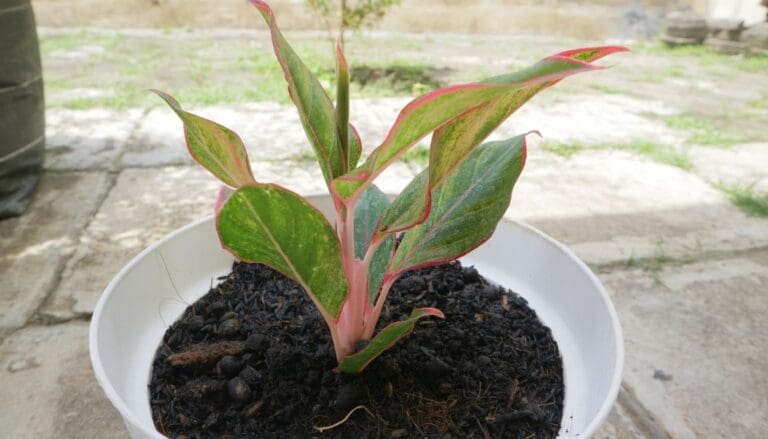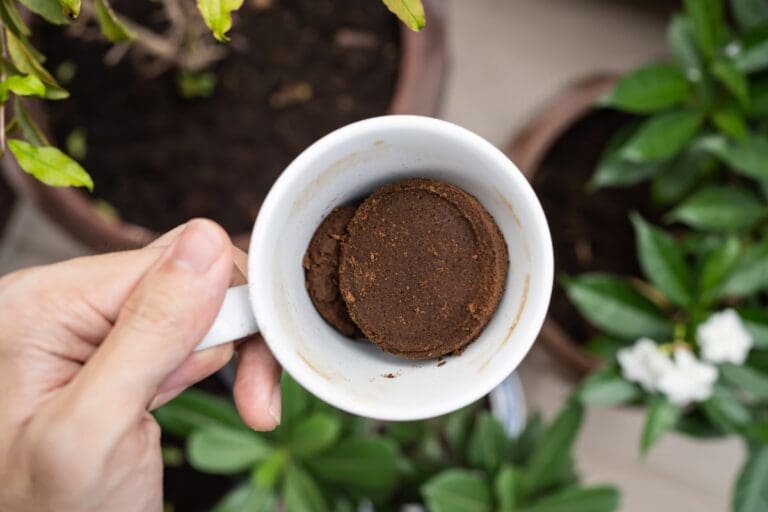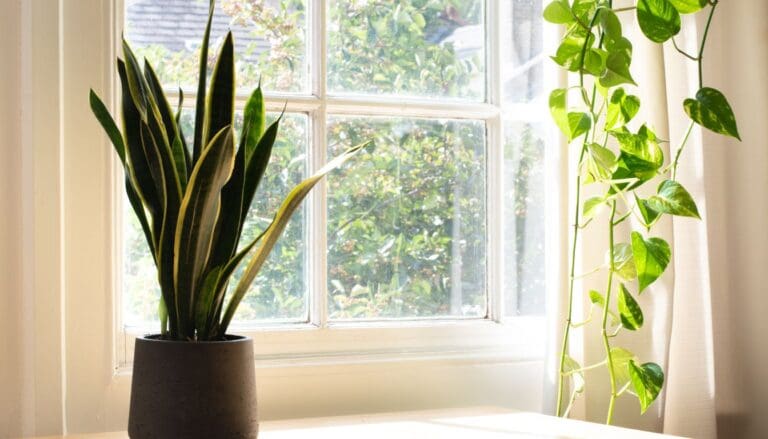8 Reasons Why Your Croton Is Wilting(+Easy Fix)
Croton is a popular houseplant with beautiful green, scarlet, yellow, or orange foliage. Although their care routine is easy to follow, neglecting a few factors while bringing up croton can cause serious health complications such as wilting.
So, in this article, we shall discuss why is your croton wilting and how to fix the same.
In general, when your croton loses turgidity and fails to stand straight, the leaves wilt to retain the remaining moisture. The possible cause can be overwatering or underwatering as both can lead to loss of nutrients and moisture in crotons. Lack of humidity can also be a possible problem.
Let’s understand the reasons behind the wilting of your Croton leaves.

Please note: Simplify Plants is reader-supported. Some links in the post are affiliate links and I get a commission from purchases made through links in the post.
What is wilting?
Turgor pressure, which is the intracellular fluid pressure exerted on the cell membrane, plays an important role in maintaining the balance and rigidity of the plant.
Reducing this turgor pressure due to many overlapping factors can ultimately result in wilting your favorite croton, which is a plant’s defensive mechanism to cope with this emergency condition.
By doing so, the plant tries to hold on to the moisture, but in most instances, the plant loses its rigidity, and the stem and leaves hang shabbily.
There can be many causative factors behind wilting, but the good news is if detected early, you can easily revive your plant to its previous state with some prompt efforts.
Why is my croton wilting?
| Possible Problems | Solution |
|---|---|
| Underwatering & Dry soil | Water the crotons adequately and keep the soil moist. |
| Overwatering | Check the soil before watering and never water if the soil is already soggy. |
| Low humidity | Group the plants together, Mist them occasionally, or Use a humidifier if possible. |
| Temperature fluctuations | Maintain a stable temperature indoors and keep the plant away from drafts. |
| Repotting stress | Avoid frequent repotting, Provide a stable environment after repotting. |
| Pest infestation | Spray neem oil, Use insecticidal soap or commercial pesticides if necessary. |
| Excess light | Keep the plant away from intense sun, Provide partial shade during the hottest part of the day. |
| Plant Disease | Look for signs of disease, take the necessary steps to fix the problem. |
Let’s go further into this article to know more about the causes and deal with the wilting in crotons.
Crotons get affected by underwatering and extremely dry soil.

Crotons require consistent routined watering for healthy growth, and your croton will reward you if you maintain the proper watering schedule.
Failing to maintain that will ultimately lead to affecting the plant.
As the soil becomes extremely dry due to insufficient water supply, the plant cells experience a massive decrease in turgor pressure, resulting in wilting leaves.
Besides wilting, underwatered croton leaves become brown and crispy from edges or curl.
How to fix it?
You must first identify the contributory factors behind dry soil.
Both insufficient watering and inadequate moisture can cause dry soil.
Your croton may also be exposed to too much sunlight or have become root-bound.
If the soil appears too dry, water soaking could be an effective way out.
Put your croton into a bucket or bathtub and fill it with water up to 3-4 inches.
The water must be at room temperature.
Allow your plant to sit in it for an effective period to absorb sufficient water.
Once the soil is evenly moist, don’t forget to let the excess water drain out.
- To avoid bone-drying of the soil, maintain a steady watering schedule after checking the moisture.
- You can even go for a capillary method for the uniform water distribution. Moisten the soil evenly by sprinkling water. Then add the required amount of water slowly. The moist soil particles will allow easy absorption.
- Keep a regular check of the soil condition. Water it again when the top 3-4 inches of the soil become dry.
Also read:
- What Kind Of Soil Does A Croton Need? (+Ideal Soil Mix & Requirements)
- How Often To Water Croton Plant? (Watering Schedule+Watering Problems)
Crotons start wilting due to overwatering.
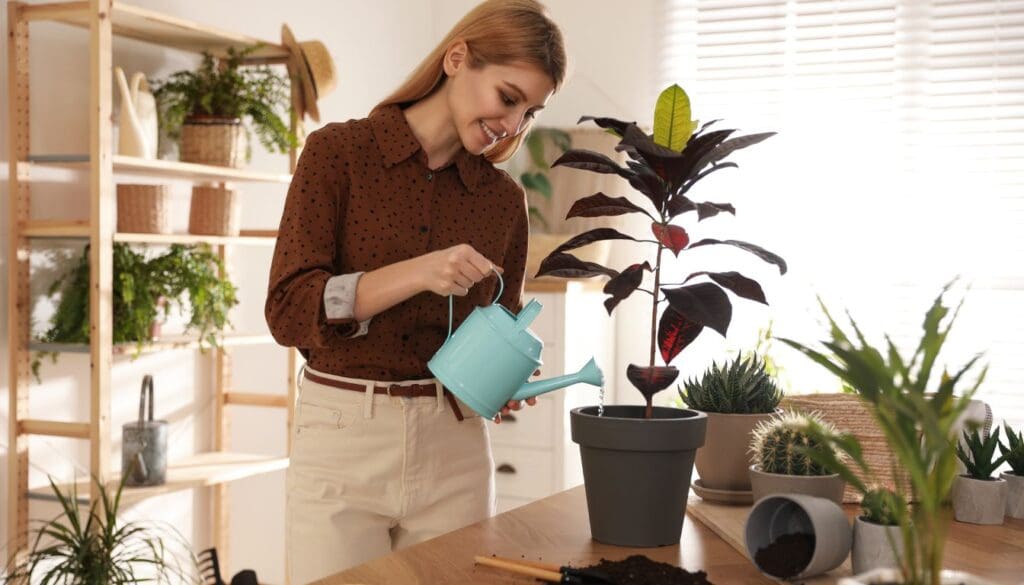
While lack of water is a concerning reason behind croton wilting, you can not eliminate the chances of overwatering behind your wilting crotons.
Overwatering prevents oxygen supply into the roots, due to which they fail to function.
Without proper root functioning, the plant fails to absorb any nutrients or water, and thus the leaves start to wilt to hold on to the remaining moisture in them.
Signs to look for:
These are some basic signs and symptoms to identify whether your croton is wilting due to overwatering.
- Damp soil: One of those obvious hints is a 24×7 damp, soggy soil.
- Rotting smell: if your croton stands on damp soil for too long, it will eventually experience root rot. You are likely to get a rotting smell if it has gone too far.
- Leaf issues: As the plant experiences an overall unfavorable condition in the soggy soil, the plant’s food factory receives the maximum harsh effect. Leaf edema, drying out leaves, leaves withering are common signs of overwatering.
- Leaves with yellow, brown spots: As the plant’s health deteriorates, it becomes more prone to bacterial infection, which appears as recurring brown or yellow spots on the leaves.
How to fix it?
If you can trace this problem early and before root rot occurs, you can revive your plant. Just follow a few of these things to avoid overwatering.
- Hold off watering for a few days until the soil becomes dry.
- Keep the Croton in a bright spot where it gets sufficient light.
- Tilt the pot to get rid of the standing water.
- If you get a foul smell from the soil, inspect the roots of the croton.
- If you notice decaying roots, prune those and repot the Croton in fresh potting mix and a new or cleaned pot.
Also read: How To Save Overwatered Croton Plant? (Signs, Problems & Solution)
Croton leaves can wilt due to low humidity
Humidity is an important factor for tropical plants.
They require high humidity for optimum growth and can wilt without enough humidity.
Without enough moisture in the air, the leaves wilt to preserve the remaining moisture inside them.
Therefore, if you have a tropical plant in the house, such as croton, you must provide enough humidity to keep it healthy.

How to provide enough humidity to croton?
You can provide enough humidity to croton by following these:
- Install a humidifier or keep it near one if you already have it.
- Group other humidity-loving plants with croton so they will transpire and increase the humidity around themselves.
- You can place the croton near an aquarium if you have one as the water evaporates from the aquarium and adds humidity in that area.
- Prepare a pebble tray for your Croton by adding pebbles to a tray and filling it with water. Now, place the croton on the pebbles and ensure that the water doesn’t get in the drainage holes. When water evaporates from the tray, the humidity around the plant increases.
Also read: Do Crotons Need Misting? (+Maintaining Ideal Humidity)
Wilting croton due to temperature fluctuations
Crotons prefer consistent warm temperatures and don’t appreciate temperature fluctuations.
65-80°F is the ideal temperature range for Crotons.
However, the plant will get stressed if you place the Croton in a spot where it gets too high or low temperatures or is exposed to constant fluctuations.
How to save Croton from temperature fluctuations?
Keep these tips in mind to protect croton from temperature fluctuations.
- Avoid placing the Croton in spots with intense direct sunlight that will absorb all the moisture out of the plant, leaving it dry.
- Don’t keep the Croton too close to fireplaces, furnaces, or other heating sources.
- Avoid keeping the Croton near windows and doors that are closed and opened too frequently.
- In winters, keep your Croton in a well-insulated area.
- Don’t choose drafty places for your Croton and keep it away from windows, coolers, or air conditioners.
Also read: What Temperature Can Croton Tolerate? (+Ideal Temperature Range)
Croton wilting due to repotting stress

Crotons don’t enjoy being repotted too often, which puts them through unnecessary stress.
If you repot the croton too often, the leaves will wilt due to being in an unhealthy state.
Repotting stress can also occur if you repot the Croton in winter, which is not the ideal time as the conditions are unfavorable for the growth of these plants.
How to save croton from repotting stress?
You can save your croton from repotting stress if you consider all the external factors while repotting.
- Repot croton only when it gets rootbound, has root rot, is heavily infested with pests, or has any other fungal disease.
- Try to repot in summer or spring when the plant remains most active and the external conditions are suitable for its growth.
- Water the Croton after repotting it to reduce the stress.
- It is not unusual for the croton to undergo some stress after repotting, so make sure you take proper care of it by providing bright light, proper watering, correct temperature, humidity, etc.
Also read: When Can You Repot Croton Plant? (+How To Repot)
Croton wilting due to pest infestation
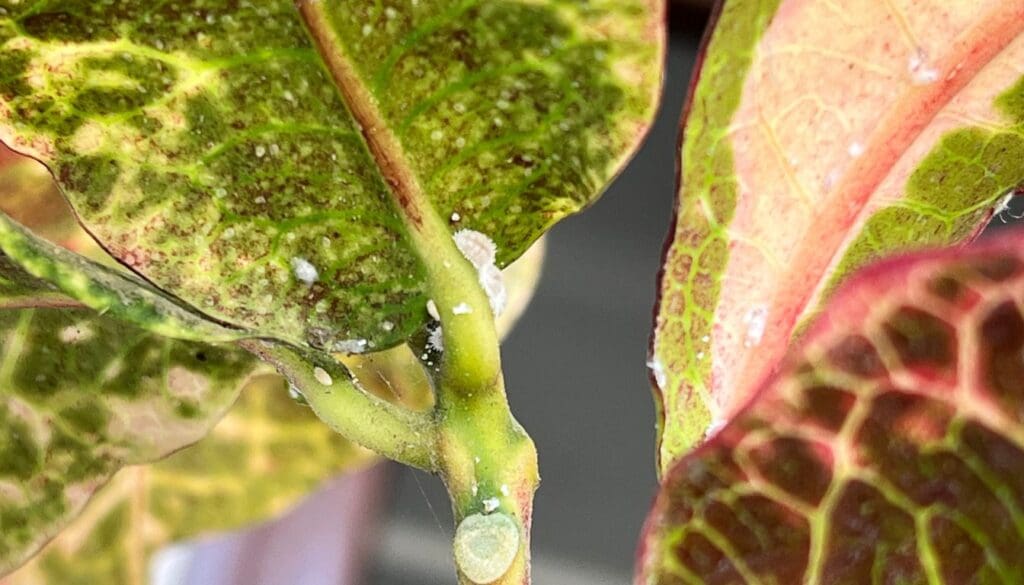
Pests are dangerous for plants as they suck the nutrients out, leaving them fragile.
If you can’t find any other reason behind the wilting of croton leaves, inspect the plant and check for pest infestations.
Since pests suck the nutrients from the plants, they become weak, and the leaves wilt as a coping mechanism.
If you find any pest on your croton, act immediately.
How to remove pests from croton?
Pests spread fast and take over the entire plant within a short period, so you must act fast and remove the pests as soon as possible.
- First, inspect the plant and isolate it if you find pests.
- Now prune all the heavily infested areas with a sharp and sterilized pruner.
- Now, prepare a neem oil spray by diluting neem oil with water and spray this mix all over the croton.
- Continue this for at least 2 weeks.
- If the pests still don’t go away, use a pesticide but read the instructions carefully before applying.
Also read: How Do I Get Rid Of Bugs In My Croton Plant? (Common Bugs+Fix)
Croton can wilt due to excess light.

All plants require light for functioning, but excess or too intense light will never be suitable for the plant.
Crotons can thrive in full sun to partial shade, but if you expose them to intense afternoon sunlight, the leaves will get scorched and wilt to prevent the loss of all the water.
How to save croton from intense sunlight?
If you can correct the location of the croton, you can save it from intense sunlight.
- Avoid placing your Croton in spots where it gets intense afternoon sunlight.
- If you place the Croton near a south-facing window, use curtains to filter the intense sunlight.
- If you take the croton outside, find a considerably shady spot for the plant.
- If the Croton already received intense sunlight and has wilted leaves, prune the damaged foliage and move it to a spot with less intense sunlight.
Also read: Can Crotons Get Too Much Sun? (Sunburn?)
Croton wilting due to diseases
If your Croton doesn’t get favorable conditions, it is not unlikely that the plant will develop fungal or bacterial diseases.
If the plant doesn’t get enough light or gets too much water, you might notice fungal and bacterial diseases after a few days.
You can save Croton from diseases and wilting by taking care of all its basic requirements and not exposing it to unfavorable conditions.
Also read: How To Revive A Dying Croton Plant? (Possible Problems+Fix)
Final thoughts

Croton is an attractive houseplant with colorful foliage, but you might notice wilting leaves on it if something goes wrong with its care.
If you want to prevent wilting, inspect your croton frequently, water when the soil gets dry, provide full sun or indirect bright sunlight, fertilize during the active months, and neither overdo anything nor deprive the plant of its basic needs.
Also read: How To Care For A Croton Plant? (Ultimate Care Guide)
Reference: Sciencedirect, Wikipedia, Wikipedia, Britannica, CABI, Academia, University of South Florida, The University of Georgia.
Recommended Garden Supplies
| Product Image | Our Recommended Gardening Supplies | Check Offers! |
|---|---|---|
Top Top
Top
Top
Top
Top
Top
Top
Top | rePotme Houseplant and Tropical Classic Potting Soil Mix | Check Offer On Amazon |
 Top
Top
Top
Top
Top
Top
Top
Top | Espoma Organic Indoor Plant Food | Check Offer On Amazon |
 Top
Top
Top
Top
Top
Top
Top
Top | GooingTop LED Grow Light 6000K Full Spectrum Clip Plant Growing Lamp | Check Offer On Amazon |
 Top
Top
Top
Top
Top
Top
Top
Top | Soil Moisture Meter | Check Offer On Amazon |
 Top
Top
Top
Top
Top
Top
Top
Top | Govee Hygrometer Thermometer, Bluetooth Enabled! | Check Offer On Amazon |
 Top
Top | LEVOIT Humidifiers for Large Room(Best For Plants) | Check Offer On Amazon |
 Top
Top
Top
Top
Top
Top
Top
Top | Upgraded DIY Automatic Drip Irrigation Kit, 15 Potted Houseplants Support | Check Offer On Amazon |
 Top
Top
Top
Top
Top
Top
Top
Top | Stainless Steel Heavy Duty Gardening Tool Set | Check Offer On Amazon |
 Top
Top
Top
Top
Top
Top
Top
Top | Bonide Insecticidal Soap | Check Offer On Amazon |
 Top
Top
Top
Top
Top
Top
Top
Top | Bonide 32 oz Spray Neem Oil for Organic Gardening | Check Offer On Amazon |
 Top
Top
Top
Top
Top
Top
Top
Top | Garden Safe Fungicide | Check Offer On Amazon |

